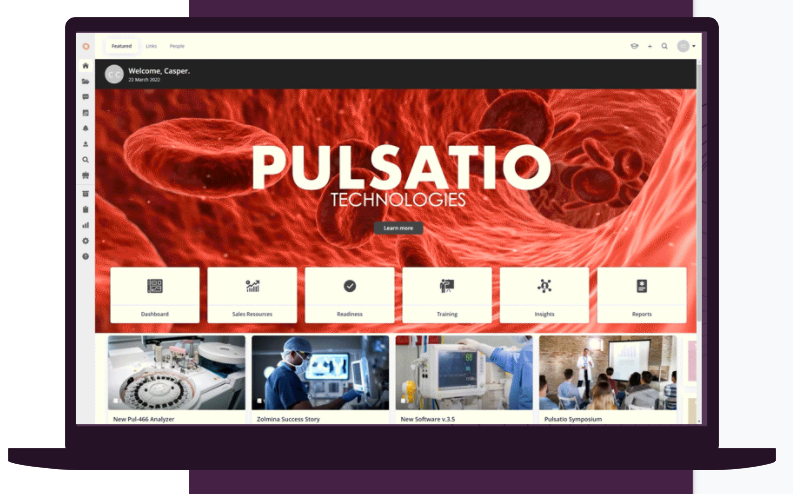When most people think of mobile content management, they think of content repositories, some of the most popular in business being:
All of these file repositories do have iOS and Android apps, so they can qualify as mobile content management solutions.
 Microsoft Sharepoint and Google Drive mobile app examples from the app store.
Microsoft Sharepoint and Google Drive mobile app examples from the app store.
But the common issue among them at the enterprise level is that they (with some exceptions like SharePoint “sites”) just store files in a “folder-inside-a-folder” method, like desktop file systems have for decades. This is fine if you have ten or 100 files. But it’s woefully inadequate at the enterprise scale, when you have tens of thousands of employees, each with many files they use, edit, create, and share daily.
Expecting a simple folder structure to handle this is unrealistic. Tens of thousands of files require thousands of folders, which quickly become difficult to manage and organize. We’ve even worked with organizations that had full-time content managers, and still struggled to create a useful system.
These issues are exacerbated on personal mobile devices where screen space is limited. A true enterprise level mobile content management (MCM) solution needs more than putting files in folders and basic search.
In this post, we’ll discuss what these requirements are, how our product Bigtincan addresses these challenges, and cover some other products on the market.
We hope this gives those who are looking for mobile content management software a better understanding of the space and a more refined filter when choosing a solution that will work for their organization.
Why simple file repositories are not sufficient for enterprise mobile content management
At enterprise organizations with tens of thousands of employees, each of them using and/or creating multiple files, using a folder-in-a-folder file repository like Google Drive or Box leads to serious inefficiencies such as:
- Employees having trouble finding the files
- Employees using the wrong files or versions
- Employees circumventing the system and just storing files locally on their own devices
- Lots of person-hours lost to just finding, sharing, creating, and discussing files
A single file structure across an entire organization fundamentally won’t solve these issues because different employees or teams prioritize different files. For example, the hierarchy of how a sales team may group assets is different than how the marketing or customer success team may do it. How do you handle that with a simple folder-in-a-folder method? You need a better system.
Also, document automation becomes a need at the enterprise level. For example, customer-facing teams like sales often need to customize documents like a sales pitch for each prospect, which is usually done manually (copy the file, rename it, open it, go to each field that needs customer data and enter it manually). This is extremely time consuming and inefficient.
Challenges are amplified on mobile devices
On mobile, browsing 15 layers of nested folders to hunt for a specific file is extremely cumbersome. Not to mention sharing, bookmarking, or editing documents.
Also, mobile often means limited connection. Employees may be on a plane, in a restaurant, or in a building with a poor connection yet they still need to be able to access, edit, and manage files.
A common scenario where a lot of these issues arise at once is when a salesperson is out in the field with a prospect. Say the prospect asks a question and the sales person needs a marketing asset to answer it. They have to, on a mobile device, navigate the entire file structure (or SharePoint site) of the marketing department — which is not familiar to them — to find the file.
Or if they search, say for a part number or feature that the prospect asked about, that search could surface thousands of results without any clear indication of which is the file they want.
Finally, within a company, different organizations may use different file repositories, so corporate content is scattered everywhere. One team may put everything in Dropbox or Box, another may use SharePoint sites, and another may use Google Drive. This makes the task of our hypothetical sales person even more difficult — where do they look?
What a great mobile content management system needs
An enterprise mobile content management solution needs the following:
- The ability for different teams or employees to group, bookmark, or store files the way they want, so they can access the content they need in a way that is easiest for them.
- The ability to search and find files across multiple file repositories (Google Drive, SharePoint, Dropbox, Box, etc.).
- Very advanced search, that helps surface content most relevant to the searcher and that searches more than just filenames.
- The ability to do all of this offline.
We’ll first discuss in depth how our software, Bigtincan, addresses these issues and then we’ll list other players in this space.
Mobile content management with Bigtincan
Here are the key features of Bigtincan that address the challenges above to achieve high quality, enterprise level content management.
Bigtincan is not just a file repository
First, Bigtincan is not just another place to store content. Yes, you can store files and documents in Bigtincan, but you can also continue using the existing file repositories your teams are already using.
Bigtincan adds a powerful interface to manage that enterprise content. Specifically, it helps you find, edit, share, and group your content into categories, to name just a few functions (see our Content Solution page for more).
That means if you’re using SharePoint, you can keep storing content in SharePoint. If you’re using Google Drive, you can keep using Google Drive. And so on.
This is important for organization-wide adoption. Teams don’t need to change their existing workflows and habits around content creation. They can keep their workflow and simply add Bigtincan to make finding, sharing, bookmarking and editing files incredibly easy.
Find files fast
Bigtincan adds an interface that’s custom to each team or even employee to find and work with the files they need the most. For example this tablet view can be customized by each employee:
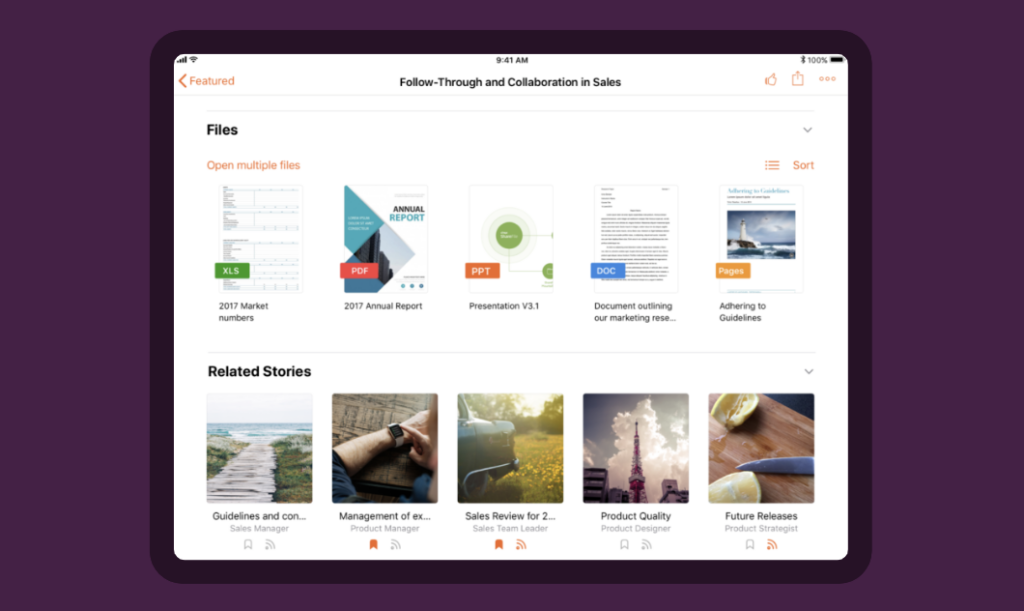
At the top they can see their most used files regardless of where they are hosted (one could be in SharePoint, another in Google Drive, etc.). If a file is updated to a newer version, Bigtincan’s AI will automatically detect it and surface the correct version.
Below, they’ll see AI-driven content recommendations (“Related Stories”) and summaries which are more than just files, but are pages or collections of content that is relevant to what they are looking at or searching for and customized to their role (sales, marketing, etc.)
Powerful, AI-driven search
Since hunting through 15 layers of folders in mobile is a huge pain, the best MCM user experience needs really powerful search. Bigtincan has this, starting with full-text search that searches inside files, not just filenames like a typical search. GenieAI also offers summaries and answers questions about content so reps don't have to read through five documents to find the right answer.
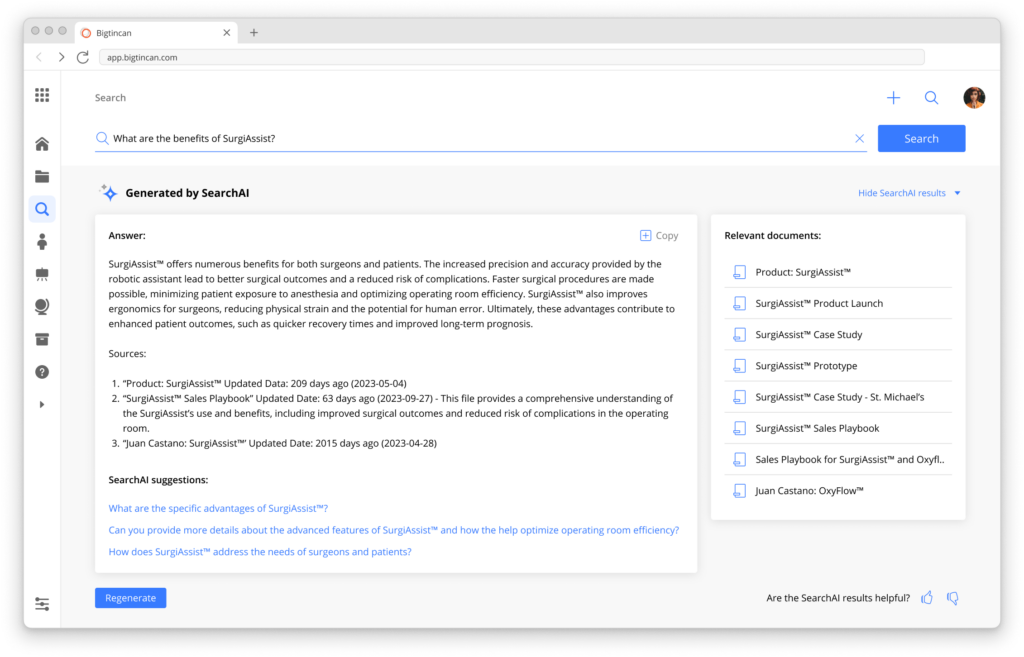
So, if our hypothetical sales person from earlier is looking for a specific part number to answer a customer’s question, they can get the relevant results even if there is no file named after the part number.
Bookmark groups of files easily
Different employees use different files frequently. For example, a sales rep may always use the same five files for sales presentations that normally are strewn across different file repositories (a deck from Sharepoint, a video on Dropbox, etc.).
Usually individual employees deal with this by keeping personal copies of these files on their own devices. But this is not ideal for the organization because it means different employees are using different versions and you can’t guarantee new changes are being adopted by your employees. Consistency in messaging or even legal compliance is hard to maintain.
Bigtincan easily solves for this with bookmark stacks. An individual user can grab any number of files located in any repository and create a bookmark stack that they can reference anywhere — online or offline.
 Add any file or page as a bookmark...
Add any file or page as a bookmark...

And easily reference it later in your personal stack.
These stacks can be put on their Bigtincan dashboard or homepage for easy reference without changing the original location of the file.
Share any file size instantly, know exactly who opened what
Typical file sharing at any company means emailing attachments. For one-off file sharing this is not a problem, but for organizations needing to share files frequently — such as an enterprise sales team — it’s inadequate.
First, large attachments may be blocked by email programs or take a long time to share or download on slow connections. Second, there are no analytics or insights into whether your recipients viewed the files, and if so, which ones and how often.
With Bigtincan, you can share any number of large or small attachments and the recipients are pointed to a microsite where the attachments are linked to. This means attachment size is never a problem, and you get analytics on who viewed what file.
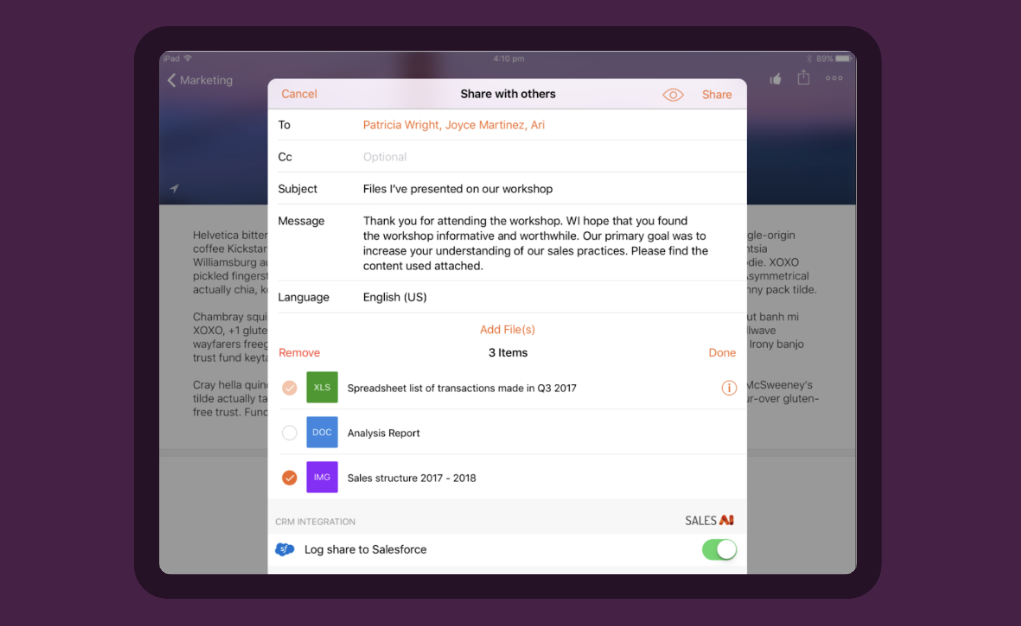
Analytics on who opened which file and how often can help sales and marketing teams close more deals by knowing what a prospect is interested in and when they should engage the prospect.
Mobile-first design
We design Bigtincan to be mobile first. That means, file browsing is easy on mobile:
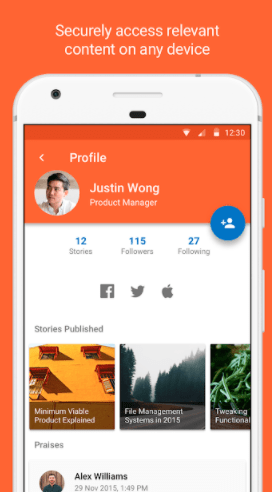
Presentations can be displayed beautifully on mobile (PowerPoint, Google Slides, etc.):
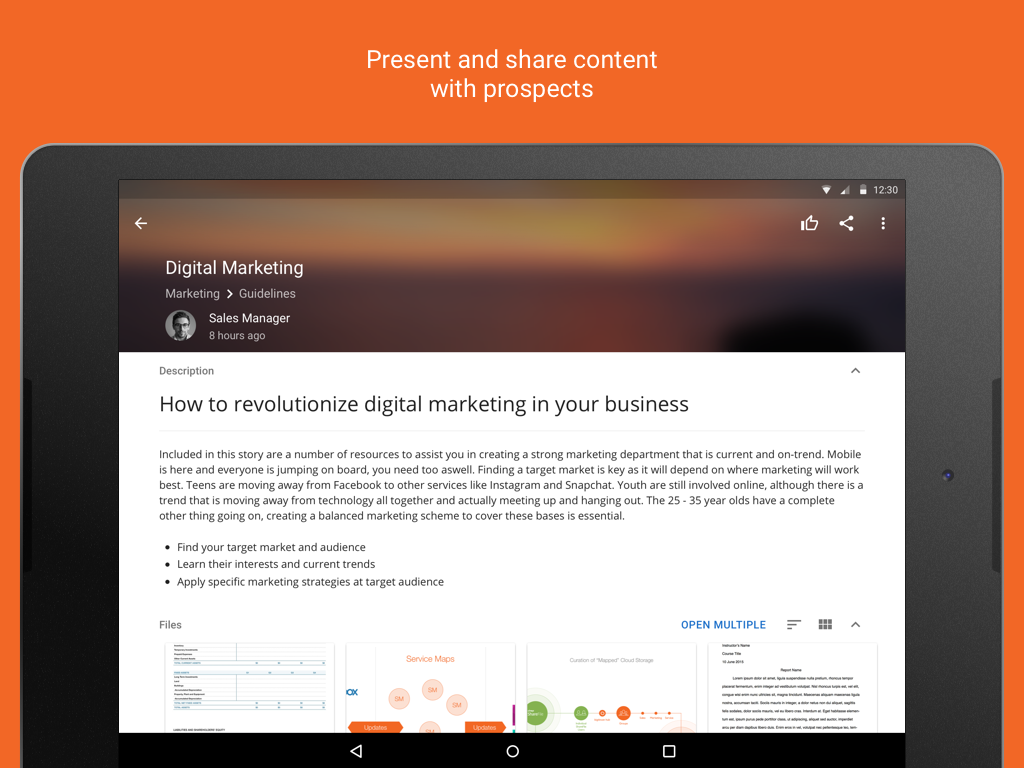

And, Bigtincan works seamlessly with the native storage on any mobile device. You can access all the same files offline on Android and iOS that you would on a desktop computer, regardless of file type or what apps you have installed.
Finally, we’ve noticed that most of our mobile customers need the best offline functionality. So we designed our AI engine to help manage your limited mobile storage capacity. This means Bigtincan will automatically download your individual files and the most important files for your organization based on a multi-factor algorithm and move old or unused files to the cloud as needed.
Total customization and branding
The entire Bigtincan platform can be completely customized. The dashboard and interface can be branded and customized for a specific company or department so it’s specific to their workflow and style, so a company can essentially have their own branded mobile application for content management.
For example, here is a custom-branded Bigtincan interface for sales reps of a Healthcare product company, built to let them easily show prospects different products and offerings:
Total offline access
Finally, nearly all features and functionality of Bigtincan are available offline: Full text search, sharing, bookmark stacks, content suggestions, and more. Since we built Bigtincan to be mobile first, we knew it had to work in limited or no connection situations.
More Features
The above features are just a start. Bigtincan has many other useful features like:
- Editing files and presentations right inside of Bigtincan
- Messaging and chat for teams and coworkers
- An entire learning management and training system (discussed in this case study)
Get a custom demo of Bigtincan
If the above features feel like they could solve your mobile content management challenges, we encourage you to request a custom demo, where we can learn the exact needs of your organization and show examples of how Bigtincan can help.
Other mobile content management solutions
There are many software solutions that have some level of mobile content management in them. Listing them all out with a review would take a long time, so instead let’s discuss them in groups, so you can get a sense of what may work for you depending on your needs.
Popular mobile file repositories
The four common SaaS players in this space are:
Of these, the most common at the enterprise level, in our experience, seem to be Microsoft SharePoint and Google Drive, because they come standard with either Microsoft (Outlook) corporate email or Google Workspace (formerly G Suite).
These are largely content repositories, meaning you store files in a folder-in-a-folder system. But all four have a range of more advanced features like document transfer, syncing of files from other repositories, offline capabilities, etc. You can learn more about each on their websites.
We’ve also written a full in depth article about document management in SharePoint for those looking to compare that to Bigtincan.
Leading sales enablement tools
There's a lot of overlap between sales enablement tools and mobile content management since sales teams:
(1) Are on the go a lot, so mobile is essential.
(2) Are constantly showing, reviewing, and sharing content.
Even Bigtincan itself has historically been one of the biggest players in the sales enablement space. Other leaders in this space include:
These options are most similar to Bigtincan. So, if you’re interested in mobile content management for a sales team and want to know how these products compare, we wrote an in-depth article comparing all three with us, Bigtincan: Seismic vs. Hubspot vs. Showpad vs. Bigtincan.
Mobile content management systems and mobile device management
Finally, “content management solutions” also has a few additional meanings beyond referring to an organization managing it’s documents, files, or digital assets. In particular mobile content management may refer to:
- Publishing: Managing website, social media, or other customer facing content.
- Mobile security: Keeping corporate data and mobile devices secure — often referred to as mobile device management (MDM) and enterprise mobility management (EMM).
An extended discussion of each of these is beyond the scope of this article, but here are a few popular options in these categories:
- Publishing: Obviously WordPress is one of the most popular content management systems (CMS) in the world, powering something like a third of the 10 million most popular websites — remember there is the open source WordPress.org and the managed hosting version Wordpress.com. Enterprise options in the "headless" CMS category (letting brands publish content to many different platforms, aka produce “omnichannel digital experiences”) is the API driven Contentful, and the open source alternative, Ghost.
- Mobile Security: Microsoft's Enterprise Mobile Security solution is a great place to start if you’re looking for security solutions for managing mobile devices and EMM. Other popular choices include options from ManageEngine, VMWare, and IBM.
Again, Bigtincan specializes in mobile content management for enterprise companies who want an efficient, offline enabled, mobile friendly interface to store, manage, share, and edit documents and content of all types.
If this is what you’re looking for, we encourage you to request a demo, where we can learn the exact needs of your organization and show examples of how Bigtincan can help.
